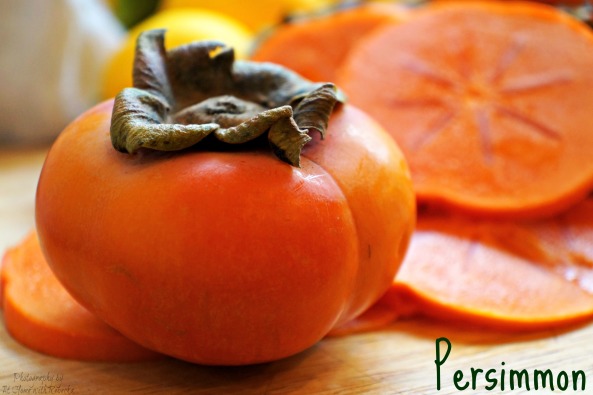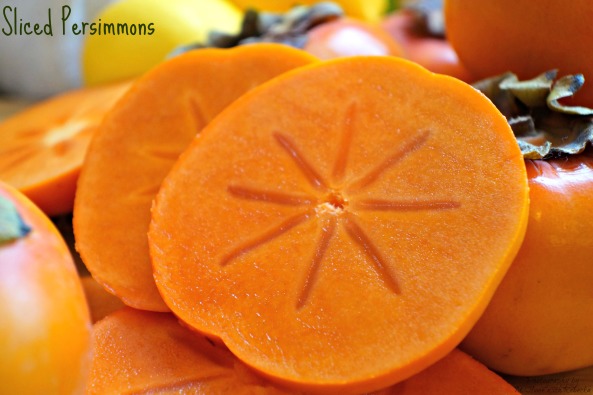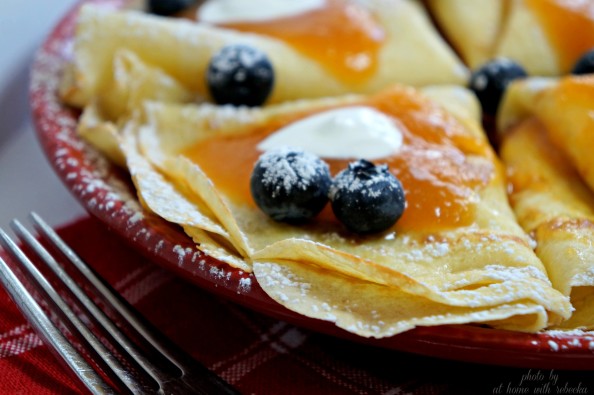
Delicious Condiment
Persimmons are a stunning fruit visually and viscerally. Mildly tart, their flavor is reminiscent of sweet papaya, but with a firmer texture. They are the perfect flavor and consistency for making persimmon butter!
Persimmon butter is a delicious condiment, especially when spread on toast, bagels, or English muffins. This is an easy home canning recipe.Enjoy persimmon butter on your morning muffin, crumpets, toast, or my new personal favorite, French crepes.
Persimmons (UK /pəˈsɪmən/ or US /pərˈsɪmən/) are the edible fruit of a number of species of trees in the genus Diospyros. Diospyros is in the family Ebenaceae. The most widely cultivated species is the Asian persimmon, Diospyros kaki. In color the ripe fruit of the cultivated strains range from light yellow-orange to dark red-orange depending on the species and variety. They similarly vary in size from 1.5 to 9 cm (0.5 to 4 in) in diameter, and in shape the varieties may be spherical, acorn-, or pumpkin-shaped.[1] The calyx generally remains attached to the fruit after harvesting, but becomes easy to remove once the fruit is ripe. The ripe fruit has a high glucose content. The protein content is low, but it has a balanced protein profile. Persimmon fruits have been put to various medicinal and chemical uses.
Like the tomato, persimmons are not popularly considered to be berries, but in terms of botanical morphology the fruit is in fact a berry.
SOURCE: WIKIPEDIA
Disclaimer
Persimmons have a mid range PH level which is right on the cusp of safety standards for water bath canning. This recipe is tested "safe" if canned with other higher acidic fruit such as pears, lemons etc. I follow tested water bath canning methods for this recipe but store the sealed, small batch jars in the refrigerator for up to one month.

Persimmon Butter
Ingredients
- 20 peeled and cubed persimmons about 6 cups chopped fruit
- ½ cup bottled lemon juice
- 1 cup water
- Sugar to taste optional
- 1 Cinnamon stick optional
Instructions
- Peel, hull and cube persimmons
- In a large heavy bottom stock pot, combine fruit, 1 cup water, and ¼ cup of lemon juice
- Cook over medium heat allowing fruit to soften and release juices, about 30 minutes
- Add remaining lemon juice and taste for sweetness, add sugar to taste if necessary
- Bring to a boil and cook for 2 minutes stirring constantly to keep the bottom of the pan from burning
- Remove from heat
- With a potato masher or using an immersion blender, blend until consistency is smooth like Butter, it should resemble thick applesauce.
- Pur hot butter into sterilized jars, leaving ¼ inch headspace,
- Remove air bubbles by running a thin knife around the side of the jar, wipe rims with a damp clean towel to remove any food residue, top with clean lids and screw on rims
- Transfer to large water bath with enough water to cover jars, bring water to a boil, begin processing time at the boil, and process for 15 minutes
Notes
CANNING SAFTEY: Persimmon has a pH value right on the cusp of being unsafe for water bath canning, I suggest combining persimmons with another more acidic fruit and always use bottled lemon juice. I follow tested water bath canning methods for this recipe but store the sealed, small batches in the refrigerator for up to one month.




Jen
PS- I also just thought of something. In recent years, the NCFHC added a recipe for canning figs which are much more alkaline than persimmons. I believe they're around 5.5 on average!
athomewithrebecka
Jen, I thought you might also like my Persimmon Lemon Marmalade recipe.
https://athomewithrebecka.com/persimmon-lemon-marmalade/
Jen
Yum!! Thank you so much and for the answers to my questions. I appreciate it!
athomewithrebecka
Always happy to help! xoxo
Jen
Hi,
I'm excited about your recipe! First, just so you know where I'm coming from, I'm somewhere in between a by the book canner and a rebel canner. I pay attention to the science and only make sensible swaps, but I also have common sense. I get a bit frustrated by our society which needs warning labels on Tide pods but written permission to create canning recipes.
So, now that you know where I'm coming from, here are my questions: I cannot have white sugar (which I know is pH neutral), but I would like to add some honey (which is fairly acidic). I would not be storing this in the fridge, but rather on the shelf. I accept responsibility for that outcome. If I pressure can it, would make it too astringent? Have you noticed any change in taste with higher temperatures? Do you think the consistency is thin enough for the heat to penetrate in a pressure canner?
Also, would you mind sharing how you test your pH at home? I'm just nosey and am curious about pH meters. 🙂
Thanks!
athomewithrebecka
Hi Jen, First, thank you for visiting At Home with Rebecka and asking some very excellent questions.
I agree with you 💯 when it comes to the crazy food labeling and fear related to food safety in these modern times; it can be mind-boggling at times. Another mind-blowing topic... what's the difference between certified organic and organic? However, I'll have save that debate for a later discussion. lol!
I'm a proponent of safe canning methods to keep our family and friends from bacteria that can make them sick or in worst cases cause death. I work hard to inform readers if I'm sharing heirloom "untested" recipes versus NCFHC recipes. I really love the fact that you mentioned taking responsibility for the outcome of an untested recipe using alternate sweetening agents.
I'll do my best to answer each of your questions just keep in mind, that I'm not an expert when it comes to the science of canning but I have years of home canning experience.
1. Canning with honey vs granulated sugar:
Sugar is optional in my recipe as the persimmons cook down to a very nice sweetness naturally. I only add sugar if the persimmons are bland or naturally unsweet with no exact measurements, usually 1/4 cup at a time. Honey would work well in this instance as it needs less cooking time.
I think it would be best for you to test a batch of persimmon butter with a mixture of honey and date sugar. Consider 1/2 cup honey and 1/4 cup date sugar with my recipe and then test for taste. If you like it sweeter, add more honey or date sugar and keep track of your changes for the next batch. Process the persimmons per recipe instructions then test for the PH level (notes for test strips below). Your persimmon butter will be darker and appear browner when using honey or date sugar. I'm only guessing that the viscosity will be thinner when using honey but that's not a bad thing. You can cook it down more if it's too thin.
2. Pressure Canning Persimmon Butter vs Water Bath Method:
Honestly, I've never tried it and after I searched google for 10 minutes, I wasn't able to find any articles on the matter. Sorry I wasn't able to give a better answer.
I'd suggest pressure canning half a batch of persimmons butter recipe and water canning the other half. This way you can test the ph level of both when done. You will have to sacrifice a jar of each to test the outcome but well worth it to know which would have a longer and safer shelf life. However, still, no way to test for botulism after being stored at room temp.
3. Pressure canning will help the heat to penetrate the fibrous fruit better than the water bath method but without testing in a lab, I wouldn't be able to give you 💯 safety rating.
4. Ph test strips are super cheap on Amazon and are what I use in my kitchen.
Here's the link: Plastic pH Test Strips, Universal Application (pH 0-14), 100 Strips | Saliva | Soap | Urine | Food | Liquids | Water with Soil Testing | Lab Monitoring
Thanks again for taking the time to visit my blog and for your willingness to ask questions. I hope some of what I shared helps!
Happy Canning, Rebecka
Katrin
I’m very new to canning and just recently acquired 85 persimmons (I must have been out of my mind ????) which is how I found your site. I’m going try your recipe but the comments sections has just educated me to another level - thank you!!! I had never heard of The National Center for Home Food Preservation and while I had heard of Ph l have never seen it so succinctly stated.
athomewithrebecka
Hello Katrin, I'm so happy you found At Home with Rebecka and my recipe for persimmon butter.
What a score to acquire 85 persimmons! I adore the flavor of the little beauties and hope you enjoy the butter recipe as much as I do.
The National Center for Home Food Preservation is the absolute best place to study canning guidelines. Please stay in touch. I'd like to hear how your first batch of persimmon butter turns out. Happy canning! Rebecka
Mimi
I made persimmon jam last year
And it was amazing. This year’s first batch got cooked in my crockpot with lemon and sugar to make a persimmon butter. I was surprised how dark it got even with lemon . Tastes good and will make a case of pints. More persimmons are ripening and will become lovely orange colored jam. Third batch will be skinned and frozen I n Smaller freeze bags then double bagged for freshness. Might make fruit leather later on. The persimmon’s Delicious flavor deserves to be enjoyed all year.
athomewithrebecka
Hi Mimi, thanks for visiting At Home with Rebecka. I agree 💯 Persimmons make the best jam and butter and deserve to be enjoyed year round! I’ve also had a few batches that turn out darker even with the addition of lemon juice however, the flavor is always delicious!
I love your idea of making fruit leather with persimmon. Please let me know how it turns out!
LIsa Semler
Hi Rebecka, I recently canned delicious organic tomatoes from our garden and even though the recipe called for bottled lemon juice I added fresh lemon juice. Do you know if the Ph in fresh lemon is sufficient to inhibit the botulism?
athomewithrebecka
Hi Lisa,
The National Center for Home Food Preservation states that a tested recipe that is safe for consumption requires the addition of bottled lemon juice. The reason bottle lemon juice is used in "tested and safe" recipes is that the level of acidity can be measured during manufacturing. Tomatoes are lower in PH so it's vital you use bottled lemon juice when canning them even if using a pressure method as opposed to water bath. The same goes for permissions. Fresh lemon juice can vary in acidity so unless you have the tools to test PH levels at home you run the risk of not having enough acid to kill botulism spores. I use fresh lemon juice when canning to add flavor but I always add the required amount of bottle lemon juice for safety.
Here is the guide for canning tomatoes found on the NCFHP site.
Selecting, Preparing and Canning Tomatoes
Introduction
Quality: Select only disease-free, preferably vine-ripened, firm fruit for canning.
Caution: Do not can tomatoes from dead or frost-killed vines. Green tomatoes are more acidic than ripened fruit and can be canned safely with any of the following recommendations.
Acidification: To ensure safe acidity in whole, crushed, or juiced tomatoes, add two tablespoons of bottled lemon juice or 1/2 teaspoon of citric acid per quart of tomatoes. For pints, use one tablespoon bottled lemon juice or 1/4 teaspoon citric acid. Acid can be added directly to the jars before filling with product. Add sugar to offset acid taste, if desired. Four tablespoons of a 5 percent acidity vinegar per quart may be used instead of lemon juice or citric acid. However, vinegar may cause undesirable flavor changes.
If a procedure from the USDA Complete Guide to Home Canning for canning tomatoes offers both boiling water and pressure canning options, all steps in the preparation ("Procedure") are still required even if the pressure processing option is chosen. This includes acidification. The boiling water and pressure alternatives are equal processes with different time/temperature combinations calculated for these products. The pressure processing options in these products were not developed for tomatoes without added acid.
Related Page: Acidifying Tomatoes When Canning
This document was adapted from the "Complete Guide to Home Canning," Agriculture Information Bulletin No. 539, USDA, revised 2009.Reviewed July 2015.
If you have any further question feel free to contact me. Happy canning
Pam
Hello Rebecka,
I'm excited to use your persimmon butter recipe. I am surprised that you are doing a water bath canning since some say that persimmons are too low acid to water bath. If you can assure me that it is safe, I will certainly use your method, and be really happy about it!
athomewithrebecka
Hi Pam, Thank you for asking if canning persimmons is safe and if my recipe is tested.
Let me start by saying that I am not a food scientist or professionally employed canning expert. I do however, adhere to the USDA guidelines when sharing recipes for canning at home. I do my very best to share recipes that are tested and safe for consumption and to honor the ethical practice of informing my readers if a recipe is USDA Tested or home grown variety. I'm sorry I didn't specify the "Tested" status of my Persimmon Butter for waterbacth canning. I have added additional "bottle lemon juice" to the recipe to elevate the pH to a safe level for waterbacth canning method. I have feed my family home cooked canned goods for years and no one has ever gotten sick however, when you're canning at home, you assume the risk even if the recipe is "tested".
The sad news is that, when canning at home there's no way of knowing if a person(s) will adhere to all the rules and safety guidelines the USDA require to produce a 100 percent safe product especially, without the use of an industrial kitchen. Due to the nature of unforeseen issues in home such as, cleanliness and recipe prepration, there's just no way to make a blanket guarantee. Not to mention, you can still grow botulism in a "tested"recipe do to a bad seal or other malfunctions with the jar, lids and rims. If you have a moment please take a look at my disclaimer posted on my site concerning the issue.
With that said...
Let me share some information that might aid you in making a decision as to the safety of canning persimmons! You can then make a more educated decision before making the recipe.
The USDA web site lists persimmons at 4.25-4.7. They are borderline acidic which means you must use a preservative that is acidic enough to kill off micro-organisims, like botulism.
Here's a quote from one of my favorite canning resources Food In Jars that will explain the process better than I can.
"If you’ve been canning for any length of time, you’ve probably heard mention of acid levels in relation to safe boiling water bath canning. Anything that is preserved in a boiling water bath must have a high acid content. The reason that high acid levels are important is that the presence of acid inhibits the germination of botulism spores into the botulism toxin. Botulism spores can only develop into the botulism toxin in low acid, oxygen-free environments.
When you preserve something in a boiling water bath canner, you heat the jars and their contents to the boiling point (that temperature varies depending on your elevation, but at sea level the boiling point is 212 degrees F). That heat is enough to kill off the micro-organisms that can cause spoilage, mold, or fermentation, but it’s not enough to kill botulism spores (they require far higher temperatures). The process of boiling the jars also helps to drive the oxygen out of the jars, creating a vacuum seal. For jars that have sufficient acid content, the result is a jar of food that is safely preserved and shelf stable.
The way food scientists (and home canners) determine whether something is high or low in acid is by pH. If something has a pH of 4.6 or below, it is deemed high in acid and is safe for boiling water bath canning. If the pH is 4.7 or above, it is considered low in acid. We’ll talk more about how to preserve those foods that are low in acid and have a pH of 4.7 or above another day, but to give you just a hint, that’s often where a pressure canner comes in.
If a food is close to the 4.6 pH point, you can often add enough acid to bring that product into the necessary safe zone. Fruits like tomatoes, figs, asian pears, melons, persimmons, papaya, white peaches and white nectarines, and bananas are often just a bit too low in acid in their natural state for safe canning. So in order to lower the pH to a safe level, we add either bottled lemon or lime juice, or powdered citric acid to products featuring those ingredients. Once the acid levels are high enough to inhibit the botulism spore’s ability to germinate into a deadly toxin, that product is safe for boiling water bath canning." Source: FoodInJars.com
Sorry for writing a novel to answer your question. I hope I've given you enough information to feel safe making my recipe for Persimmon Butter. You can add more bottled lemon juice if you have worries the pH is not high enough. Always consider more research if you feel my recipe calculations are not safe. Thank you for reaching out to me. Feel free to contact me anytime.
Annette
thank you so much for the information on the bottled Lemon Juice, i am in awe of this knowledge!, i am making you're persimmon butter recipe this weekend and i JUST bought the bottles lemon juice.. i wont be using sugar or cinnamon as the persimmons are amazing . Do u think i really have to peel the persimmons? I have made persimmon jam in the past and didn't peel them and it was good 🙂
athomewithrebecka
Hi Annette, You're so sweet. Thank you so much!
Peeling the persimmons is entirely up to you. My only concern would be achieving the smooth texture of the persimmon butter with the peels left intact. However, I've never tried the recipe with the peels on so can't say for sure. I would be honored to hear back from you with the results. Please let me know how it turns out! Happy Canning, Rebecka